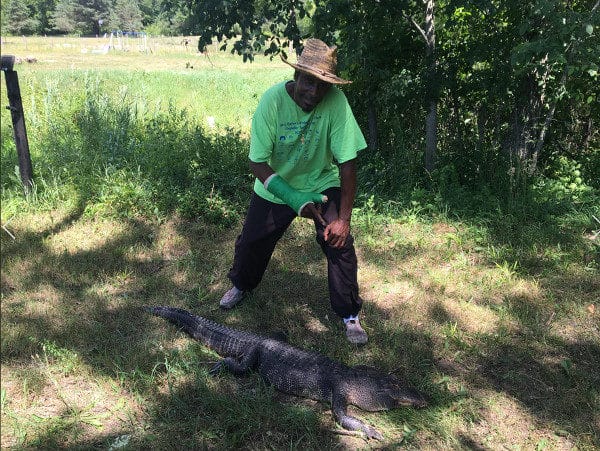
U.S.A. –-(Ammoland.com)--(Ammoland.com)- On Saturday, 20 July 2019, Derrick Fells was trapping minnows on his 17-acre property in Tuscola, County, Michigan. Fells was carrying a pistol. He heard a hissing sound and thought it might be from a possum. Instead of a possum, there was a six-foot alligator sunning itself next to the Sucker Creek canal on his property.
The Alligator came toward him, and he shot it. He immediately called 911. From nbc25news.com:
Fells has about 17 and a half acres in Tuscola County’s Dayton Township and on Saturday, ended up stumbling upon an alligator while catching minnows on his property.
“There was a 6-foot alligator sunbathing and when I spooked the alligator, it turned on me to come toward me. I pulled my pistol out and I shot it. That paralyzed him and then I immediately called 911,” Fells stated.
Defense against animal attack is seldom mentioned in the debate about Second Amendment rights. It is hard to consider a more legitimate case than a person defending themselves from an animal on their own property.
The alligator had escaped from a neighbor who was in the habit of rescuing exotic animals The neighbor has two other alligators, an emu, and rattlesnakes on their property.
Derrick Fells was concerned about what might have happened if it had been a child instead of him who had stumbled on the alligator. The swing set in the upper left-hand corner of the picture indicates it was a valid concern. A loose alligator would not survive a Michigan winter. But winter is months away in July.
The case reminds me of the incident in Zanesville, Ohio, in 2011. In that case, the animal rescue person released 50 predators before committing suicide. Deputies had to shoot them for public safety. One deputy shot a wolf, a bear, and a lion, all in the same night. Many of the released animals were full-grown tigers. Tigers and lions are prolific breeders in captivity.
Shooting an alligator in Michigan, in self-defense, is little short of meeting up with Bigfoot on the probability scale. While defending against an exotic animal attack is unlikely, people use firearms to defend against animals regularly. In urban areas, defense against dog attack is the most common case.
In rural areas, residents use firearms to defend themselves and their property from multiple threats. The most common are raids on gardens, crops, and livestock by everything from bears to gophers and deer. Feral dogs are a common problem.
People who live in urban areas often have no knowledge about the necessity of defense against these threats. Too many find Fido to be a burden when moving or with a change of circumstance. They find it easier to abandon their dog in the countryside instead of delivering it to the local pound or animal shelter. The rural resident is left to clean up the mess of a starving animal trying to fend for itself. The irresponsible animal owner is able to imagine a farmer adopting a pet instead of one having to shoot a starving feral.
It isn’t fun to put down someone’s former pet turned feral. But someone has to be responsible and do it.
Farmers cannot take in every abandoned animal. They would quickly be eaten out of house and home. Animals can always breed faster than enough food can be grown to support them.
Alligators are not cute and fuzzy. We do not think of them as furry humans. They are not common as pets.
That is the reason a man shooting an alligator in Michigan is news, while a farmer shooting a feral dog in the same state, is not.
About Dean Weingarten:
Dean Weingarten has been a peace officer, a military officer, was on the University of Wisconsin Pistol Team for four years, and was first certified to teach firearms safety in 1973. He taught the Arizona concealed carry course for fifteen years until the goal of constitutional carry was attained. He has degrees in meteorology and mining engineering, and recently retired from the Department of Defense after a 30 year career in Army Research, Development, Testing, and Evaluation.
